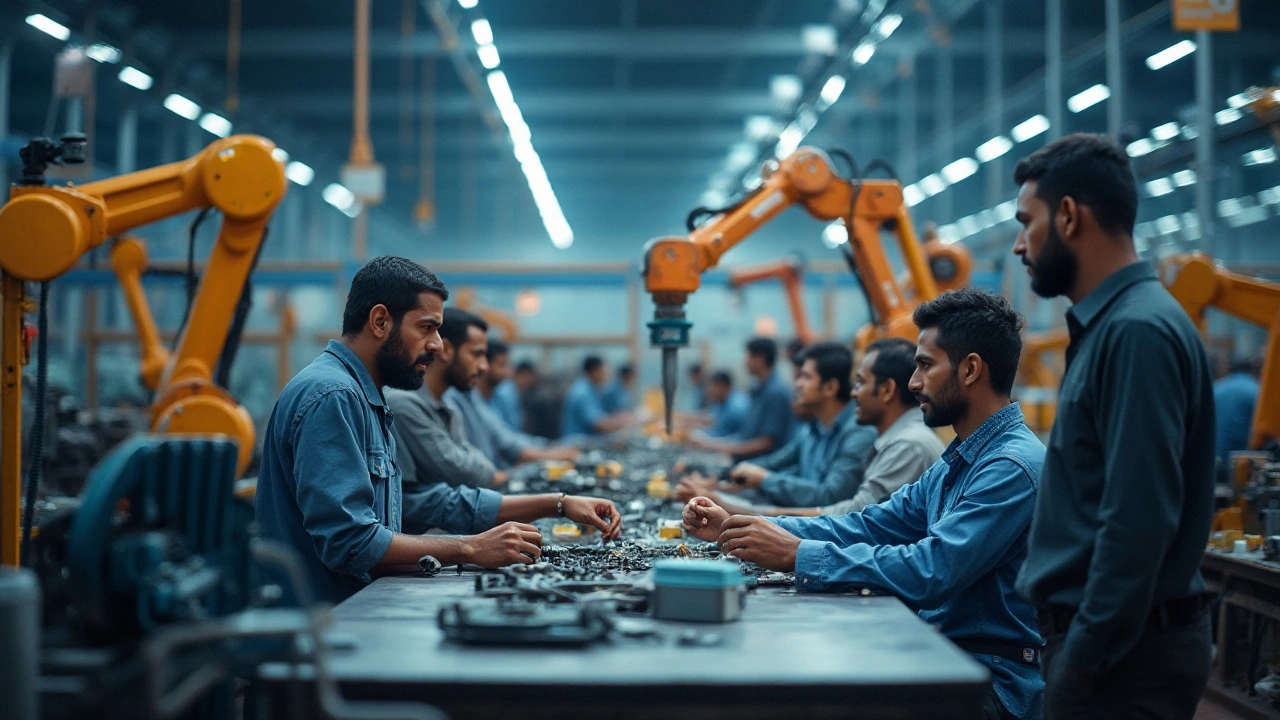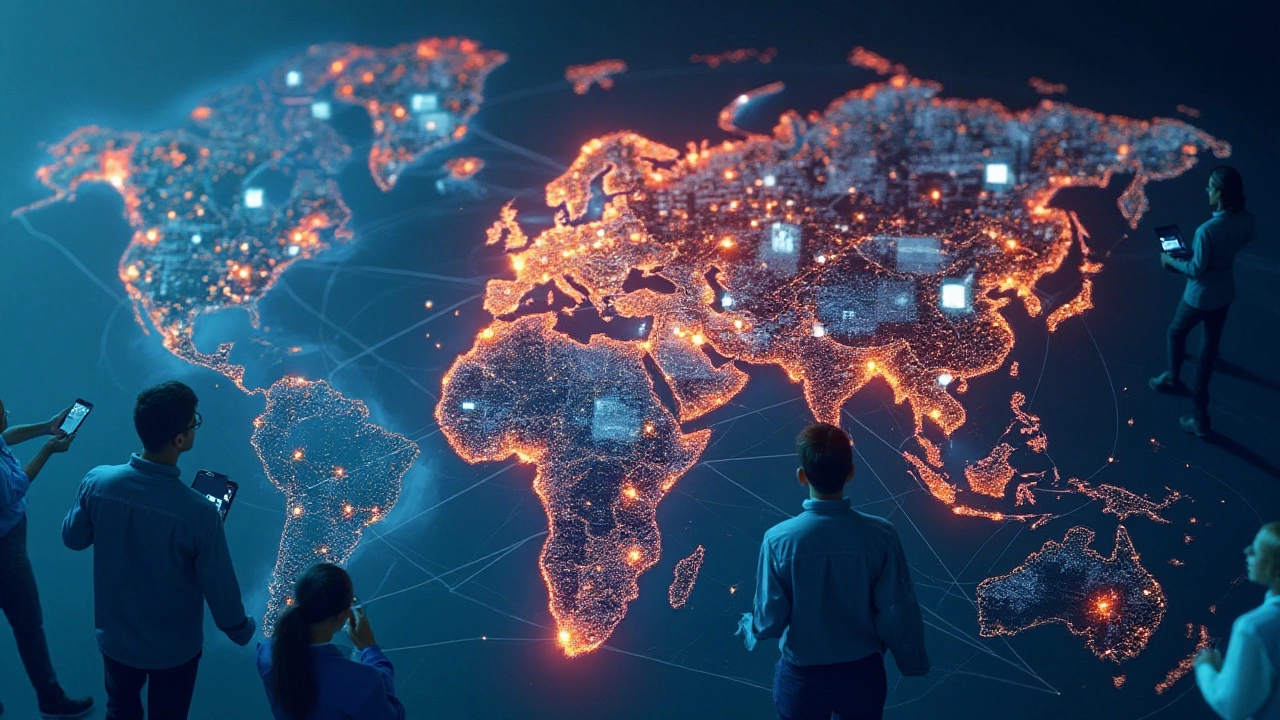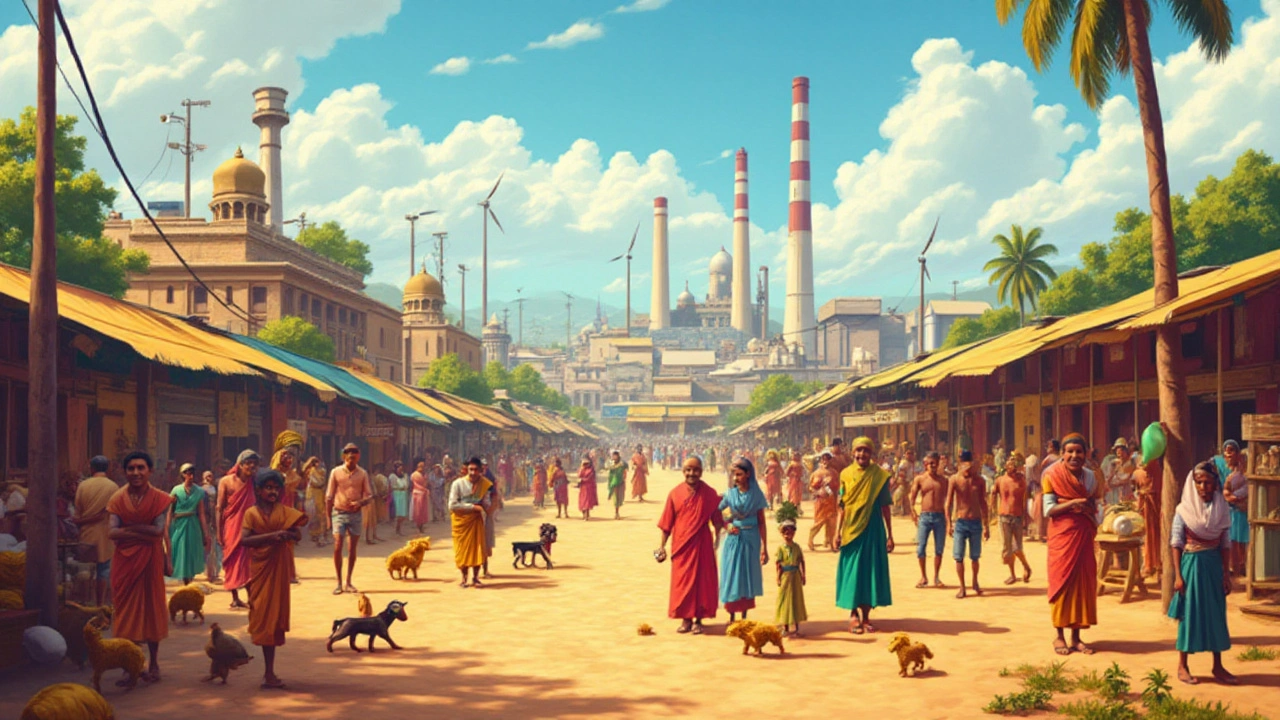 Dec, 14 2024
Dec, 14 2024
Manufacturing has long stood as a backbone of America's economic prowess, propelling not just the economy but weaving itself into the very fabric of society. It connects diverse sectors, driving innovation and providing a host of jobs. But it’s not just about machinery and assembly lines; it’s a story of evolution, opportunity, and transformation.
From the rust belt cities to Sun Belt technology hubs, manufacturing thrives on adapting. As we look into what makes this sector vital, we’ll explore how it influences everything from local job markets to national policy-making. Government schemes are pivotal in this narrative, shaping and steering the course of an industry that remains ever crucial to American growth and global competitiveness.
- Historical Significance of Manufacturing
- Modern Manufacturing Landscape
- Economic Contributions
- Societal Impact and Job Creation
- Role of Government Schemes
- Future Challenges and Opportunities
Historical Significance of Manufacturing
Manufacturing in America has a rich tapestry woven with innovation, resilience, and unprecedented growth. Dating back to the Industrial Revolution, this sector catalyzed the shift from agrarian economies to urban industrial giants. As factories sprouted up, they dramatically altered the landscape, drawing swathes of the population into bustling cities. Towns grew into major urban centers, powered by the smoke-belching mills and the roar of production lines. This seismic shift wasn't just economic; it reshaped societal norms, lifestyles, and opened up a new horizon of opportunities for many.
The late 1800s and early 1900s stand as a testament to the burgeoning power of American manufacturing. During this period, the United States rapidly industrialized, producing everything from textiles and steel to automobiles and electronics. Industries developed alongside inventions, with entrepreneurs like Ford and Edison at the helm, pushing boundaries, and fueling an insatiable drive for technological progress. This era saw the birth of mass production techniques, most notably Henry Ford's assembly line in 1913, which revolutionized the manufacturing process across the globe.
The importance of manufacturing during wartime cannot be overstated. During World War II, American factories became the 'Arsenal of Democracy,' cranking out planes, tanks, and munitions at an impressive rate. Women entered the workforce in droves, embodied in the iconic figure of Rosie the Riveter, redefining gender roles and societal expectations. Post-war, America experienced an economic boom, with manufacturing at the center, leading to prosperity and the building of a consumer-based economy. As one analyst noted, "the production capacities not only supported national defense but laid the groundwork for postwar economic dominance."
Manufacturing's evolution continued into the late 20th century with the advent of automation and globalization. Yet, it retained its critical role, becoming not just about economic survival but thriving through a fundamental transformation. Today, as we look back, it is evident that the manufacturing sector isn't merely a relic of the past but a dynamic force that has continuously adapted, a testament to American ingenuity and resilience that has shaped society and steered the nation on the global stage.
Modern Manufacturing Landscape
The manufacturing sector in America today is a tapestry of advanced technology, innovation, and skilled labor working in concert to drive the economy forward. Unlike the production lines of the past, today's factories are bustling with automation and smart technologies. Robotics and artificial intelligence have woven their way into everyday operations, reshaping how goods are produced. This transformation not only boosts efficiency but also requires a workforce equipped with new skills to manage these sophisticated systems.
In fact, the integration of the Internet of Things (IoT) has revolutionized processes, offering real-time insights and increasing operational transparency. Manufacturers are adopting these innovations at a rapid pace to stay competitive in an increasingly globalized market. The shift towards sustainable production is also gaining momentum, as companies aim to reduce their environmental footprint while maintaining high output levels. This dual focus on technology and sustainability reflects the growing consumer demand for responsibly sourced and produced goods.
"Manufacturing is more than just putting parts together. It's coming up with ideas, testing principles, and perfecting the engineering, as well as final assembly," Paul G. Allen once remarked, highlighting the comprehensive nature of modern manufacturing.
Although technology has brought about impressive advancements, it has also introduced new challenges. The demand for highly skilled workers means companies are constantly in search of creativity and technical expertise. This need has prompted educational initiatives and partnerships between industry leaders and academic institutions to ensure the next generation is well-equipped to tackle these demands. Government schemes often play a pivotal role in supporting such initiatives, fostering innovation through grants and tax incentives designed to stimulate growth and encourage research and development.
Considering the economic contributions of the manufacturing industry, it's evident that it serves as a critical pillar of America's GDP. The sector not only fuels the creation of countless jobs but also drives the export market, with goods ranging from automobiles to consumer electronics filling demand across the globe. As the sector adapts and evolves, it continues to meet the ever-changing needs of a dynamic economy, all while maintaining America's status as a hub of innovation and production excellence.

Economic Contributions
The manufacturing industry serves as a cornerstone of the American economy, representing a significant portion of the country's GDP. It's not just the sheer output of goods that highlights the importance of this sector; it's the expansive ripple effect it has across various facets of economic life. Manufacturing creates high-quality, well-paying jobs that sustain middle-class livelihoods and boost community growth. This sector is a substantial employer, with nearly 9% of the workforce engaged in producing everything from automobiles to advanced electronics. The jobs are often considered career-length opportunities, offering robust salaries and stability. The industry's commitment to innovation continually fosters a culture of research and development, which spills over into other sectors, enhancing both local and national economic landscapes.
Many people are unaware that for every dollar spent in manufacturing, approximately $2.60 is added to the economy, the highest multiplier of any sector. This multiplier effect not only enhances GDP but also encourages the expansion of the supplier base reaching beyond raw materials. Present day manufacturing does not just rely on labor-intensive processes; it has become a high-tech field that relies on skilled talent and advanced technologies. According to the National Association of Manufacturers, manufacturers in the United States perform 63% of all private-sector R&D, driving more innovation than any other sector. This continuous cycle of innovation is crucial in maintaining competitive advantage globally, ensuring that the U.S. remains a leader in industries such as aerospace, automotive, and biotechnology.
The positive effects of manufacturing are felt deeply across regions and communities, influencing not just economic strength but social well-being. For many areas, government schemes provide critical support in training and retraining workers, ensuring that the workforce can adapt to technological shifts. Such programs are vital and efficient, given that many manufacturing roles today require proficiency in areas like automation, data analytics, and digital collaboration. With the rise of Industry 4.0, the integration of Internet of Things (IoT) and Artificial Intelligence (AI) within manufacturing processes presents new opportunities for growth.
"Today's manufacturing jobs are not the jobs of our fathers and grandfathers," remarks Susan Helper, senior economist for the White House, "The factories of the future are here, and they need a highly skilled workforce to run them."The role of the manufacturing sector in driving exports cannot be overstated, with the sector accounting for 60% of all U.S. exports. This not only contributes to the national trade balance but also solidifies American presence in international markets. The strength of the American manufacturing base is vital for reducing dependency on products from abroad, while also promoting economic independence.
Moreover, the extensive network of manufacturing plants and suppliers supports a variety of local businesses, from small-town diners to large-scale logistics services, each playing their part in the economic ecosystem. This integrated approach helps create a sustainable society where developments in production technologies and consumer demands drive innovation. As we move towards the future, investments in automation and digitalization hold promise for even greater economic benefits.
Societal Impact and Job Creation
The manufacturing sector plays a pivotal role in shaping our society, more than we often realize. It’s like the quiet engine that keeps roaring in the background, powering so much of what we depend on daily. This sector doesn't just make stuff; it makes livelihoods. It creates millions of jobs, providing a stable income for countless families across a wide array of communities, both urban and rural. The ripple effect of manufacturing reaches far beyond the factory floor, stimulating growth in related sectors such as transportation, logistics, and services.
In America, the manufacturing sector employs about 8% of the workforce, translating to approximately 12.5 million jobs. This might seem like a simple statistic, but behind these numbers are real people and real stories of life-changing opportunities. As the world evolves, so does the nature of these jobs. The demand for more specialized skills is rising, leading to increased training programs and educational partnerships designed to equip the workforce for modern manufacturing challenges. According to the National Association of Manufacturers, for every dollar spent in manufacturing, an amazing $2.74 is added to the economy, showcasing its monumental impact. It’s clear that this sector acts as a significant economic multiplier.
The Center for Manufacturing Research states, "Manufacturing in America supports more than 18.5 million jobs across other sectors, further highlighting its vast importance in the economic landscape."
Manufacturing not only creates jobs, but it also elevates community standards by fostering thriving local economies. It builds better schools, roads, and healthcare facilities as tax revenues from manufacturing enterprises often fund essential services. The industry’s presence ensures bustling communities with a sense of purpose and pride. Take for example areas in the Midwest, where revitalized manufacturing has breathed new life into small towns that were at risk of economic downturn. In these ways, manufacturing serves as a catalyst, not just for personal prosperity but for collective societal growth.
Government initiatives have been instrumental in shaping manufacturing's societal benefits. Programs that provide tax incentives and subsidies encourage technological upgrades and energy-efficient practices that keep American manufacturers globally competitive while ensuring high-quality jobs remain here at home. Local governments often engage in partnerships with educational institutions to build tailored curriculums that align with the anticipated demands of manufacturing jobs. Such strategic collaboration is key, ensuring the workforce remains adaptable and ready to meet evolving industry standards.
This symbiotic relationship between manufacturing and society highlights a brighter future for innovative job creation. By gearing up apprenticeships, embracing automation with human collaboration, and focusing on sustainable practices, the sector is poised to surge ahead while maintaining its crucial societal contributions. The industry's role in job creation is not merely about numbers, but about enriching lives and communities through robust economic frameworks and sustainable growth strategies.

Role of Government Schemes
The United States government plays a pivotal role in the manufacturing sector through various schemes and policies designed to enhance competitiveness, spur innovation, and ensure sustainability. Government initiatives range from tax incentives and grants to education programs and regulatory support. These measures aim to address both current and emerging challenges, ensuring that this vital industry can continue to grow and contribute to the American economy.
One of the cornerstone programs is the Manufacturing Extension Partnership (MEP), which serves as a catalyst for small and medium-sized enterprises. This initiative provides firms with access to the latest technological advancements, helping them to upgrade their operations and remain competitive in a global market. MEP centers across the nation have assisted countless businesses in increasing productivity while reducing waste. According to the National Institute of Standards and Technology (NIST), companies working with MEP centers see an average of $4.7 billion in sales growth annually.
Another crucial government approach is the emphasis on training and education. The Advanced Manufacturing Partnership (AMP) is a collaborative effort between the federal government, universities, and private enterprises. Its aim is to bolster skills required in the rapidly evolving manufacturing landscape. This effort is crucial in preparing the workforce for the adoption of cutting-edge technologies such as artificial intelligence and robotics, which are reshaping the industry. By investing in human capital, the government ensures a steady pipeline of skilled workers ready to tackle the challenges of modern manufacturing.
"By strengthening manufacturing, we strengthen the long-term economic security for the United States. Manufacturing offers good jobs and stimulates local economies." - Source: U.S. Department of Commerce
On the financial side, initiatives like the R&D Tax Credit and the Section 179 deduction encourage businesses to invest in new research and capital expenditures. The R&D Tax Credit, for example, allows firms to deduct a portion of their research expenses from their taxable income, thus stimulating innovation. The Section 179 deduction lets businesses deduct the full purchase price of qualifying equipment or software, encouraging modernization and efficiency improvements.
Looking ahead, the Green Manufacturing initiative is set to take center stage, aligning manufacturing processes with environmental goals. This involves developing sustainable practices, minimizing carbon footprints, and adopting clean energy sources. Government policies support these shifts through subsidies and grants aimed at reducing the environmental impact of manufacturing, fostering a balance between industrial progress and ecological stewardship.
The role of government schemes in manufacturing is multifaceted, affecting everything from educational outreach to financial incentives. Each program, whether focused on innovation or sustainability, plays a part in maintaining the industry’s strength. With these strategic supports, manufacturing is likely to remain a cornerstone of the American economy, bolstering society and driving progress.
Future Challenges and Opportunities
The future of manufacturing in America sits at an intriguing crossroads, where untapped opportunities are intertwined with formidable challenges. On one hand, technological advancements present a host of possibilities. Automation and artificial intelligence are redefining efficiency and productivity, yet they bring with them concerns about the displacement of the labor force. Job transitions within the industry require attention, as workers need to be re-skilled to handle complex machinery rather than traditional tasks. The question remains: how can this transition be managed to benefit workers while boosting the economy?
Adding to the equation are the global competition and supply chain vulnerabilities that became glaringly apparent during the pandemic. The reshoring of America's manufacturing operations is a hot topic, emphasizing the need for a resilient domestic supply chain. As geopolitical landscapes shift, the balance of maintaining cost efficiency while ensuring national security adds another layer of complexity. The government, in its role, must navigate these waters skillfully.
Environmental responsibilities cannot be sidelined in this discourse. Manufacturing, known for its significant economic contributions, also carries the weight of reducing its carbon footprint. Initiatives to adopt sustainable practices, such as using renewable energy sources and reducing waste, are no longer optional but necessary. Policies need to align with these eco-friendly practices, nudging the industry towards greener processes without stifling growth. The climate crisis compels us to act decisively, blending innovation with responsibility.
Technological Integration and Workforce Readiness
Embracing digital transformation involves integrating new technologies into the existing manufacturing frameworks. However, it demands an equally robust focus on workforce readiness. This goes beyond just training; there's a need for a cultural shift where continuous learning is embedded within the industry's fabric. Skilled labor is essential to harness the potential fully, making educational and training programs key areas for investment.
“The nation that leads in renewable energy will be the nation that leads the world.” —President Joe Biden
This quote encapsulates the direction and ambition necessary for manufacturing to thrive in the coming decades. Governmental support through educational incentives and subsidies for tech adoption becomes crucial. The collaboration of public and private sectors could pave the path to a seamless transition, fortifying America's position as a leader in manufacturing while safeguarding the planet. This attitude fosters resilience as the industry navigates through today’s existential challenges.
Embracing New Markets and Innovations
Emerging sectors like biotechnology, advanced materials, and electric vehicles provide fertile ground for innovation. American manufacturers can capitalize on these new markets, driving economic growth by investing in research and development. Encouraging venture capital investments in these realms promises not only profits but also positioning America as a hub of innovation. The next decade is ripe with potential; unlocking it requires foresight and strategic alignment with technological trends.
In summary, as we stand on the brink of a manufacturing renaissance, the ability to adapt to rapid changes while addressing environmental, economic, and social challenges will define the future trajectory of American manufacturing. Crafting a future where technological genius and human ingenuity coexist harmoniously is key, ensuring the sector remains a cornerstone of societal progress.